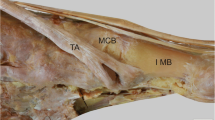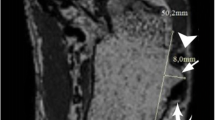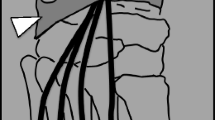Abstract
Purpose
The purpose of this report was to demonstrate the normal complex insertional anatomy of the tibialis posterior tendon (TPT) in cadavers using magnetic resonance (MR) imaging with anatomic and histologic correlation.
Material and methods
Ten cadaveric ankles were used according to institutional guidelines. MR T1-weighted spin echo imaging was performed to demonstrate aspects of the complex anatomic distal insertions of the TPT in cadaveric specimens. Findings on MR imaging were correlated with those derived from anatomic and histologic study.
Results
Generally, the TPT revealed a low signal in all MR images, except near the level of the medial malleolus, where the TPT suddenly changed direction and “magic angle” artifact could be observed. In five out of ten specimens (50%), a type I accessory navicular bone was found in the TPT. In all cases with a type I accessory navicular bone, the TPT had an altered signal in this area. Axial and coronal planes on MR imaging were the best in identifying the distal insertions of the TPT. A normal division of the TPT was observed just proximal to the insertion into the navicular bone in five specimens (100%) occurring at a maximum proximal distance from its attachment to the navicular bone of approximately 1.5 to 2 cm. In the other five specimens, in which a type I accessory navicular bone was present, the TPT directly inserted into the accessory bone and a slip less than 1.5 mm in thickness could be observed attaching to the medial aspect of the navicular bone (100%). Anatomic inspection confirmed the sites of the distal insertions of the components of the TPT.
Conclusion
MR imaging enabled detailed analysis of the complex distal insertions of the TPT as well as a better understanding of those features of its insertion that can simulate a lesion.











Similar content being viewed by others
References
Blake RL, Anderson K, Ferguson H. Tibialis posterior tendonitis: a literature review with case reports. JAPMA 1994; 84: 141–149.
Kaye RA, Jahss MH. Tibialis posterior: a review of anatomy and biomechanics in relation to support of the medial longitudinal arch. Foot Ankle 1991; 11: 244–247.
Schweitzer ME, Caccese R, Karasick D, Wapner KL, Mitchell DG. Tibialis posterior tendon tears: utility of secondary signs for MR imaging diagnosis. Radiology 1993; 188: 655–659.
Conti S, Michelson J, Jahss M. Clinical significance of magnetic resonance imaging in preoperative planning for reconstruction of tibialis posterior tendon ruptures. Foot Ankle 1992; 13: 208–214.
Pomeroy GC, Pike RH, Beals TC, Manoli A. Acquired flatfoot in adults due to dysfunction of the tibialis posterior tendon. J Bone Joint Surg 1999; 81: 1173–1182.
Morgan J, Benard MA, Smith S, Rhodes SD, Meis CM, Hambrecht S. Use of tensor fascia lata in the correction of tibialis posterior tendon dysfunction. Lower Extremity 1997; 4: 7–16.
Myerson MS. Adult acquired flatfoot deformity. J Bone Join Surg 1996; 78: 780–792.
Mann RA. Biomechanics of the foot. In: American Academy of Orthopaedic Surgeons, editor. Atlas of orthotics: biomechanical principles and application. St. Louis: C. V. Mosby; 1975: 264.
Mann RA. Flatfoot in adults. In: Mann RA, Coughlin MJ, editors. Surgery of the foot and ankle. St. Louis: C. V. Mosby; 1993: 757–784.
Sarrafian SK. Anatomy of the foot and ankle. Philadelphia: JB Lippincott; 1983: 216–219.
Kiter E, Erdag N, Karatosun V, Günal I. Tibialis posterior tendon abnormalities in feet with accessory bone and flatfoot. Acta Orthop Scand 1999; 70: 618–621.
Kiter E, Günal I, Karatosun V, Korman E. The relationship between the tibialis posterior tendon and the accessory navicular. Ann Anat 2000; 182: 65–68.
Bareither DJ, Muehleman CM, Feldman NJ. Os tibiale externum or sesamoid in the tendon of tibialis posterior. J Foot Ankle Surg 1995; 34: 429–434.
Grogan DP, Gasser SI, Ogden JA. The painful accessory navicular: a clinical and histopathological study. Foot Ankle 1999; 10: 164–169.
Chen YJ, Hsu RWW, Liang SC. Degeneration of the accessory navicular synchondrosis presenting as rupture of the tibialis posterior tendon. J Bone Joint Surg 1997; 79: 1791–1798.
Fernandes R, Aguiar R, Trudell D, Resnick D. Tendons in the plantar aspect of the foot: MR imaging and anatomic correlation in cadavers. Skeletal Radiol 2007; 36: 115–122.
Author information
Authors and Affiliations
Corresponding author
Rights and permissions
About this article
Cite this article
Pastore, D., Dirim, B., Wangwinyuvirat, M. et al. Complex distal insertions of the tibialis posterior tendon: detailed anatomic and MR imaging investigation in cadavers. Skeletal Radiol 37, 849–855 (2008). https://doi.org/10.1007/s00256-008-0499-3
Received:
Revised:
Accepted:
Published:
Issue Date:
DOI: https://doi.org/10.1007/s00256-008-0499-3




